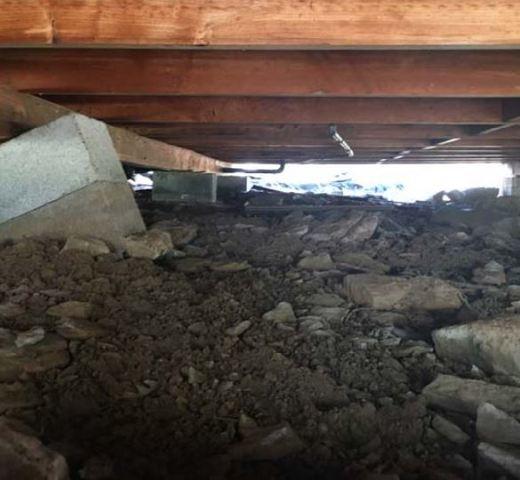Mormon Lake, AZ Underpinning Installation 6.2021
Challenge
The Homeowners of this 1965’s cabin noticed some problems with the foundation, so they preferred to call Arizona Foundation Solutions for an accurate diagnose.
The signs of stress included:
- Broken wooden piers under the house
Every Foundation project starts with a level (A) inspection was made to see any visible damages. However, an additional (B) inspection had to get done due to the circumstances, so we needed an engineering perspective.
Exterior Inspection: The exterior of the location was visually inspected. Items such as foundation cracks, exterior wall cracks, improper grading, type of structure, poor drainage, gutters or no gutters, bowed retaining walls, large trees close to the foundation and any type of obstructions that may or may not influence the repair process were noted and recorded.
Interior Inspection: The interior of the location was visually inspected. Items such as floor cracks, wall cracks, ceiling cracks, sloping floors, uneven counter tops, doors and windows that are out of alignment, cracked window glass and bowed walls were noted and recorded.
Manometer Survey: The manometer survey, also known as a floor survey, is a measurement of the differences of interior floor elevations. The flatness of the interior floor was measured using a highly accurate survey device known as a Manometer. The entire interior floor area was surveyed and the elevations were recorded. These data points were then entered into a computer program that provides a topographical map showing the high and low elevation contours of the floor surface. This topographical map shows where the foundation is out of level and shows where support and stabilization is needed. The floor survey also demonstrates whether any floor slab heave or settlement exists.
A heave pattern is observed in the east, southeast and southwestern portions of the home as indicated by the higher elevation readings on page 10 (3D Topographical Map). This phenomenon usually occurs in areas where structures are built on expansive clays. Moisture from one or any combination of the following: storm runoff, poor drainage around the foundation, plumbing leaks and/or underground moisture sources will allow the moisture/vapor to accumulate underneath the foundation. The moisture then interacts with the clayey soils, causing them to swell. The clay soils take the path of least resistance and expand upwards and lift the foundation.
After examining the home and performing the manometer survey, Arizona Foundation Solutions believes the home could be experiencing foundation settlement at the eastern portion of the home as shown by the damage lower readings on a Topographical Map. The drop off in floor elevations on the topographical map is consistent with a foundation settlement pattern. Settlement can be caused by one or any combination of many factors including sub-grade saturation of moisture due to poor drainage, years of storm runoff, plumbing leaks, improper compaction, the lack of a proper foundation system, and/or (in most cases) natural earth movement.
The Foundation Performance Association (FPA) "Guidelines for the Evaluation of Foundation Movement for Residential And Other Low-Rise Buildings" were adopted to correlate acceptable and unacceptable distress phenomena with actual survey elevations. Deflection and Tilt calculations were performed and compared to allowable values. For this engineered analysis, the deflection of the slab L/288 was more than the allowable deflection limit of L/360. In addition, the tilt of the slab (0.38%) was less than the allowable tilt of 1.00%.
Solution
Arizona Foundation Solutions believes that the proper way to permanently stop the perimeter foundation settlement is to underpin the areas that are experiencing movement. Underpinning is the process of installing deep foundation elements called piles. Piles are engineered foundation supports that are driven down past the unstable soils and are then locked up into load bearing strata, which can support the loads that are transferred to them. Once the piles have been installed, they can be used to lift the perimeter foundation up to its Highest Practical Maximum. The piles should be spaced approximately six to eight feet on center and should start and stop near the hinge points of movement (exact spacing to be determined after load bearing calculations). In this case, the piles would be located at the perimeter of the home.
AZFS believes the best way to stabilize the support beams in the crawl space is with SmartJacks. These are adjustable galvanized supports engineered to be placed under the sagging floors to help prevent settlement of the floor joist system. The SmartJack sequence should start at approximately 2’ off each perimeter wall and should not be spaced more than 7’ on center (exact spacing to be determined after load bearing calculations). An engineered push pier will be driven concentrically beneath the beam at each Smart Jack location to provide a footing for each Smart Jack. If for whatever reason the installation of concentric piers is not possible, a concrete footing of engineered size will be poured beneath the smart jack to distribute the load. The SmartJacks will then be cut to size and set in place. Finally, the units will be adjusted to lift the sagging floors back to their best functioning point or the Highest Practical Maximum.
Project Summary
Engineer: Néstor J. Brea




